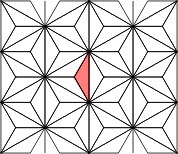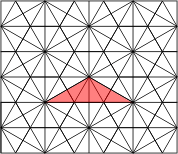Polypons are formed from 30°, 30°, 120° triangles. They form a subset of the polydrafters of twice the order. The pieces are confined to a triakis grid. If the pieces are allowed to break this first grid, then we can create the extended polypons, which lie within the grid of polydrafters as shown below.

Monopon - 1 (1 tile)
 |
Dipons - 2 (4 tiles) + Extended dipons -1 (2 tiles)
|
|
|
|
||
| 1 | 2 | 3* |
Tripons - 2 (6 tiles) + Extended tripons -3 (9 tiles)
|
|
 |
|
|
|
| 1 | 2 | 3* | 4* | 5* |
Tetrapons - 4 (16 tiles) + Extended tetrapons -14 (56 tiles)
 |
 |
 |
 |
|
| 1 | 2 | 3 | 4 | 5* |
|
|
|
|
|
|
| 6* | 7* | 8* | 9* | 10* |
 |
|
|
 |
 |
| 11* | 12* | 13* | 14* | 15* |
|
|
 |
 |
||
| 16* | 17* | 18* |
Pentapons - 4 (20 tiles) + Extended pentapons - 44 (220 tiles, not pictured)
 |
 |
 |
 |
|
| 1 | 2 | 3 | 4 |
Hexapons - 10 (60 tiles) + Extended hexapons - 184 (1104 tiles, not pictured)
 |
 |
 |
 |
 |
| 1 | 2 | 3 | 4 | 5 |
 |
 |
 |
 |
 |
| 6 | 7 | 8 | 9 | 10 |
Heptapons - 13 (91 tiles) + Extended heptapons - 674 (4718 tiles, not pictured)
 |
 |
 |
 |
 |
| 1 | 2 | 3 | 4 | 5 |
 |
 |
|
|
 |
| 6 | 7 | 8 | 9 | 10 |
|
|
 |
 |
||
| 11 | 12 | 13 |
For higher orders of polypons, the number of pieces is as follows:
Octapons - 29
Ennepons - 47
Decapons - 100
